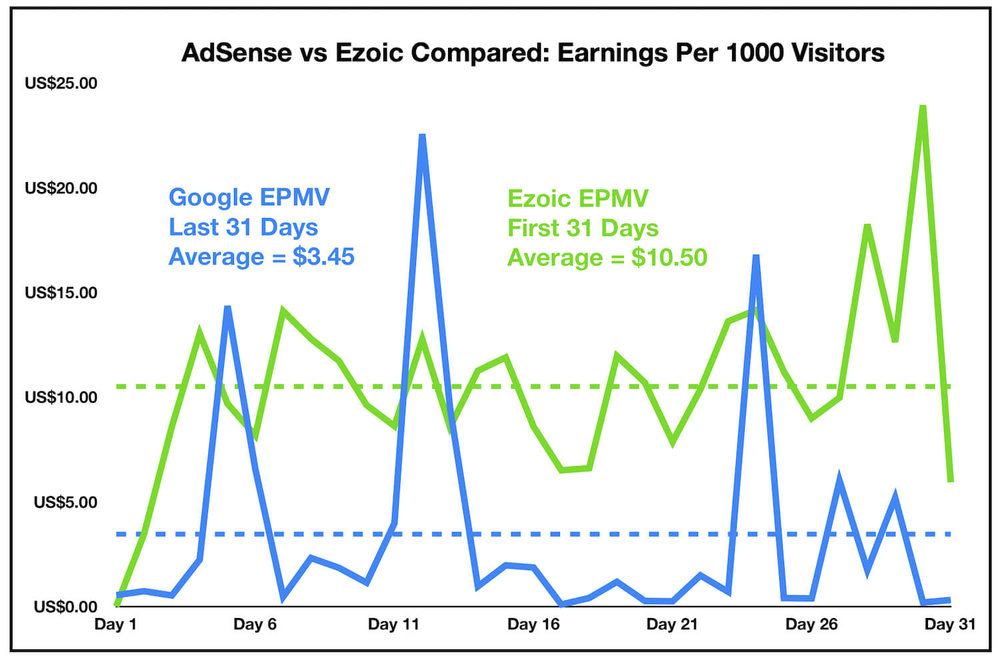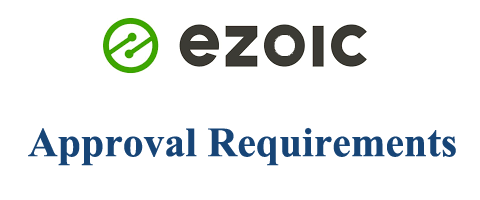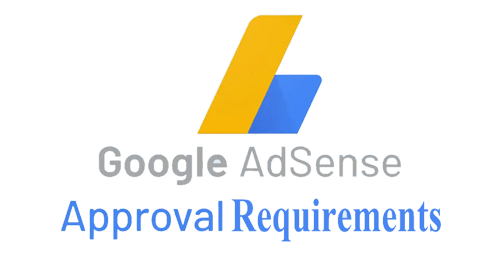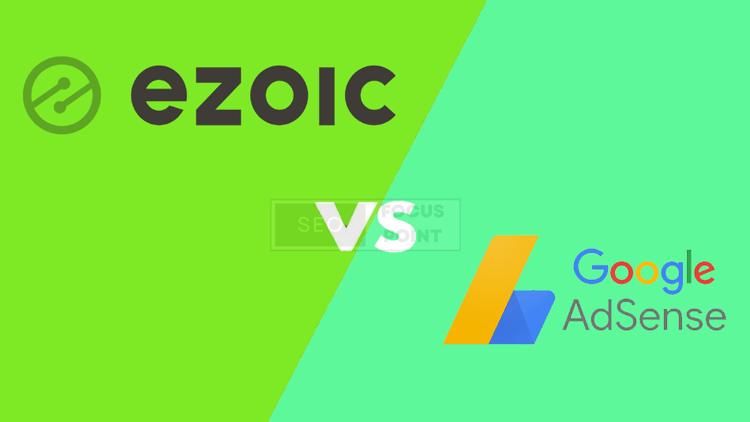When it comes to website monetization, the clash in Ezoic vs AdSense has become a hot topic of discussion. These two heavyweights in the industry offer website owners and publishers the opportunity to maximize their revenue through online advertisements.
In this article, we’ll dive deep into the showdown of Ezoic vs AdSense, examining their features, advantages, and drawbacks. By the end, you’ll have a clear understanding of which platform is the best choice for your website monetization needs. Let’s explore the battle in Ezoic vs AdSense and determine the reigning champion.
Table of Contents
Why Display Advertising is Important?
Display advertising is the practice of promoting products or brands through visual ads on websites and digital platforms. It increases brand visibility and targets specific audiences. Display advertising is important because it increases brand visibility, allowing more people to discover and recognize your brand. It enables targeted reach, ensuring your ads are shown to the right audience, and increasing the likelihood of conversions.
Display ads also drive website traffic, directing users to explore your offerings. Remarketing opportunities keep your brand in front of potential customers, encouraging them to return and take desired actions. With a variety of ad formats available, display advertising offers flexibility in engaging your audience effectively. Lastly, for publishers, it serves as a revenue-generating channel through ad impressions and clicks.
Overall, display advertising plays a vital role in brand awareness, targeted marketing, and revenue generation. Recent statistics show the following data:
- 566 billion U.S. dollars were projected to be spent on digital advertising worldwide this year, 2022.
- The U.S. is the largest digital advertising market in the world with $6 out of $10 invested in ads devoted to digital advertising.
- Display ads make up 12% of total website traffic.
- 92% of organizations have made efforts to integrate their paid and organic social efforts.
Source: onehourprofessor
What is Ezoic?
Ezoic is an innovative platform designed to help website owners and publishers optimize their online ad revenue. It offers a powerful suite of tools and features that aim to enhance ad performance and user experience simultaneously. With Ezoic, websites can leverage artificial intelligence (AI) and machine learning algorithms to automatically test and optimize various ad layouts, placements, and formats.
This dynamic optimization process allows websites to find the most effective ad configurations that maximize revenue while maintaining a positive user experience. Ezoic also provides detailed analytics and reporting, enabling website owners to gain valuable insights into their ad performance and make data-driven decisions. In summary, Ezoic offers an intelligent and automated approach to website monetization, helping publishers unlock the full potential of their online advertisements.
Key Features of Ezoic
As an alternative to Google Adsense, Ezoic has some features. Most of them are discussed below:
- Automated Ad Testing: Ezoic leverages AI and machine learning to automatically test different ad layouts, placements, and formats on your website. This feature enables you to find the optimal ad configuration that generates maximum revenue while maintaining a positive user experience.
- Revenue Optimization: Ezoic focuses on maximizing your ad revenue by continually optimizing the ad placements and formats based on real-time data. It uses sophisticated algorithms to identify the most effective monetization strategies for your website.
- Ad Mediation: Ezoic integrates with multiple ad networks and exchanges, including AdSense, allowing you to access a wide range of ad inventory. This feature ensures that your website can leverage various advertising sources to maximize your revenue potential.
- User Experience Optimization: Ezoic strives to balance revenue generation with user experience. It analyzes user behavior and engagement metrics to identify the ad layouts that provide optimal performance without negatively impacting user satisfaction.
- Data-driven Insights: Ezoic provides detailed analytics and reporting tools that offer valuable insights into your ad performance. You can track key metrics, such as revenue, impressions, click-through rates, and more, to make informed decisions and optimize your monetization strategy.
- Mobile Optimization: Ezoic understands the importance of mobile optimization in today’s digital landscape. It offers mobile-specific ad testing and optimization to ensure your ads perform effectively across various devices and screen sizes.
- A/B Testing: Ezoic enables you to conduct A/B tests to compare different ad configurations and make data-backed decisions. This feature allows you to experiment with various settings and layouts to determine the most profitable and user-friendly combinations.
- Site Speed Acceleration: Ezoic includes site speed optimization features that help improve your website’s performance. By reducing page load times, you can enhance user experience and potentially boost ad revenue.
Ezoic’s comprehensive feature set, combining automation, optimization, and user experience focus, positions it as a strong contender in the realm of website monetization, making it a worthy competitor to AdSense.
What is AdSense?
AdSense is Google’s advertising platform that enables website owners and publishers to monetize their online content. By displaying relevant ads on their websites, publishers earn revenue when visitors interact with or view these advertisements. AdSense offers a user-friendly interface, a wide range of ad formats, and access to a vast network of advertisers, making it a popular choice for website monetization.
Key Features of AdSense:
AdSense offers a range of key features that make it a highly sought-after advertising platform for website owners and publishers. Let’s explore these features in more detail:
- Contextual Targeting: AdSense uses contextual analysis to display ads that are relevant to the content of the webpage, increasing the likelihood of user engagement and click-through rates.
- Multiple Ad Formats: AdSense offers various ad formats, including text ads, display ads, responsive ads, and video ads, allowing publishers to choose the format that best suits their website and audience.
- Extensive Ad Network: AdSense connects publishers with a vast network of advertisers, ensuring a wide range of available ads to display on their websites. This network increases competition for ad space, potentially leading to higher ad rates and revenue.
- User-friendly Interface: AdSense provides a user-friendly dashboard where publishers can easily manage their ad placements, customize ad styles to match their website’s design, and track their earnings and performance through detailed reporting and analytics tools.
- AdSense Policies: AdSense maintains strict policies to ensure a high-quality ad ecosystem. These policies promote transparency, ad relevance, and user-friendly experiences, helping to maintain the integrity of the advertising platform.
- Performance Optimization: AdSense provides optimization tips and suggestions to help publishers maximize their ad revenue. These recommendations may include ad placement best practices, ad unit customization, and other strategies to enhance performance.
- AdSense for Search: Publishers can implement AdSense for Search, allowing users to conduct searches directly on their websites and generate revenue from ads displayed on the search results page.
- Payment and Support: AdSense offers flexible payment options and provides support to publishers throughout the monetization process, ensuring a smooth experience and timely payments.
AdSense’s key features make it a popular choice for website owners and publishers looking to monetize their online content effectively. It’s contextual targeting, diverse ad formats, extensive ad network, user-friendly interface, and support contribute to its reputation as a leading advertising platform.
Pros and Cons of Ezoic
Pros:
- Automated ad testing and optimization
- Revenue optimization
- User experience optimization
- Data-driven insights and analytics
- Mobile Optimization
- A/B testing capabilities
- Multiple payment options.
Cons:
- The learning curve for beginners
- Requires integration and setup process
- Monthly fee for advanced features (optional).
- The free version doesn’t offer a lot of features
- Limited control over ad networks and partners
- Reliance on AI algorithms may not suit all cases
Pros and Cons of AdSense:
Pros:
- Wide range of available ads and ad formats
- An extensive network of advertisers
- Contextual targeting for relevant ads
- User-friendly interface and management tools
- Support and resources for publishers
Cons:
- Stricter policies and approval process
- Limited control over ad placements
- Revenue shares with Google
- Potential for lower ad rates in certain niches
- Limited customization options
Please note that this presentation style provides a more concise overview of the pros and cons of each platform. It’s important to consider your specific requirements and priorities when choosing between Ezoic and AdSense.
Differences between Ezoic vs AdSense
When it comes to monetizing your website through online advertising, two popular options that often come up are Ezoic and AdSense. Both platforms offer opportunities to generate revenue by displaying ads on your website. However, they have distinct features and approaches that set them apart. In this comparison, we will explore the differences between Ezoic and AdSense to help you make an informed decision about which platform aligns best with your website monetization goals.

Image Source: Capital Matters
Let’s delve into the key disparities between Ezoic and AdSense in the following table:
| Ezoic | AdSense | |
|---|---|---|
| Ad Testing | Automated testing and optimization | Limited manual testing |
| Revenue Optimization | Advanced revenue optimization strategies | Contextual targeting for ad relevance |
| User Experience | User experience optimization | Limited control over ad placements |
| Data Insights | Detailed data-driven insights and analytics | Standard reporting and analytics |
| Mobile Optimization | Mobile-specific optimization | Responsive ad formats |
| A/B Testing | A/B testing capabilities | Limited testing options |
| Revenue share | 10% | 32% |
| Control | More control over ad networks and partners | Less control over ad networks and partners |
| Customization | Limited customization options | Customization of ad appearance and styling |
| Support | Support available | Support available |
It’s important to note that these differences are based on the general characteristics of Ezoic and AdSense and may not cover every aspect or feature. Additionally, individual experiences and specific use cases may vary. It’s recommended to thoroughly research and consider your unique needs when deciding between Ezoic and AdSense.
Requirements of Ezoic Approval
Ezoic offers a welcoming opportunity for small publishers and those new to the world of content creation. Unlike some other platforms, Ezoic doesn’t have a high qualification bar, making it accessible to a broader range of website owners. The approval process is designed to be easy and straightforward, ensuring a smooth onboarding experience.

To partner with Ezoic, here’s what you need to keep in mind:
- Page Views: Ezoic doesn’t impose a minimum traffic requirement. However, it offers different plans based on the number of page views your website receives in a month. There are separate options for beginners and established websites, catering to those with both higher and lower page view volumes.
- Content Quality: Ezoic places importance on unique and relevant content that adheres to Google’s publisher policies. It is crucial to ensure that your website publishes content that is legal, ethical, and in compliance with industry standards. Ezoic doesn’t approve websites that engage in the distribution of illegal content.
- Website Type: Ezoic prefers to partner with websites that are informational and content-rich. If your website falls within these categories and offers valuable and engaging content to users, it increases your chances of receiving approval from Ezoic.
By meeting these requirements, your website stands a higher chance of being approved by Ezoic. It’s important to carefully review Ezoic’s specific guidelines and documentation to ensure you fully understand their expectations and criteria.
Requirements of Google AdSense Approval
To get approved for Google AdSense, you need to meet certain requirements and guidelines set by Google. Here are the key factors to consider for AdSense approval:

- Content Quality: Your website must have high-quality and original content that provides value to users. Ensure that your content is unique, well-written, and adheres to Google’s content policies. Avoid publishing copyrighted material, adult content, or any content that violates Google’s guidelines.
- Website Design and Navigation: Your website should have a professional and user-friendly design that enhances the overall user experience. Ensure easy navigation, clear site structure, and proper organization of content. AdSense also requires that your website has a sufficient number of pages with unique content.
- Traffic and Age of Website: While there is no specific traffic requirement, it’s generally recommended to have a decent amount of traffic before applying for AdSense. Additionally, your website should be at least a few months old, as Google prefers websites with a history of consistent content creation.
- Ad Placement: Ensure that your website is compliant with Google’s ad placement policies. Avoid placing ads on pages with restricted content, such as thank-you pages, login pages, or error pages. AdSense has specific guidelines on ad placement, and you should familiarize yourself with them.
- Privacy Policy and Terms of Service: Your website must have a privacy policy page that clearly discloses how user information is collected, used, and managed. Additionally, having a Terms of Service page that outlines the rules and guidelines for using your website is recommended.
- AdSense Program Policies: Familiarize yourself with Google’s AdSense program policies and ensure that your website complies with them. Pay attention to guidelines related to prohibited content, click fraud, invalid clicks, and other policy violations.
Remember that Google’s approval process is thorough, and meeting these requirements doesn’t guarantee automatic approval. It’s important to carefully review Google’s guidelines, make any necessary adjustments to your website, and submit an application that demonstrates compliance with their policies.
Make a choice from Ezoic vs AdSense
When it comes to choosing one from Ezoic vs AdSense, it depends on your specific needs and goals. Both platforms offer different features and benefits, so let’s compare them to help you make an informed decision:
Eligibility
AdSense is generally more accessible and has fewer eligibility requirements. It’s suitable for smaller websites or bloggers who are just starting out. Ezoic, on the other hand, requires a minimum of 10,000 monthly visits to qualify.
Ad Optimization
Ezoic focuses on advanced ad optimization techniques to maximize your ad revenue. It uses artificial intelligence and machine learning algorithms to test different ad layouts, sizes, and placements, ensuring the best possible ad performance. AdSense offers basic ad optimization but doesn’t have the same level of customization and testing options as Ezoic.
Revenue Split
AdSense operates on a revenue share model, where publishers receive a percentage of the ad revenue generated. Ezoic also follows a revenue share model, but the percentage can vary based on your website’s performance and the plan you choose.
Control and Customization
With AdSense, you have limited control over the ads displayed on your website. AdSense automatically serves ads based on the content and user preferences. Ezoic provides more control, allowing you to experiment with different ad placements, sizes, and types to find what works best for your audience.
Additional Monetization Options
Ezoic offers additional monetization options beyond display ads, such as sponsored content, affiliate marketing, and e-commerce integrations. AdSense primarily focuses on display ads, although it does offer some ad formats like matched content units.
User Experience
AdSense generally provides a cleaner and less intrusive ad experience, ensuring that ads are relevant to the content and less disruptive to your audience. Ezoic’s optimization techniques may involve more ad placements, which can affect user experience if not carefully managed.
Conclusion
Choosing between Ezoic vs AdSense depends on your specific needs and priorities. Ezoic offers advanced revenue optimization and user experience features, while AdSense provides simplicity and contextual targeting. Consider factors like revenue goals, user experience, control, and technical proficiency when making your decision. Conduct tests and gather feedback to determine the best fit for your website. Stay informed by subscribing to our newsletter for the latest updates on website monetization strategies and tips. Subscribe now to stay ahead in the ever-evolving world of online advertising!


1 thought on “Ezoic vs AdSense: The Ultimate Website Monetization Clash 2023”